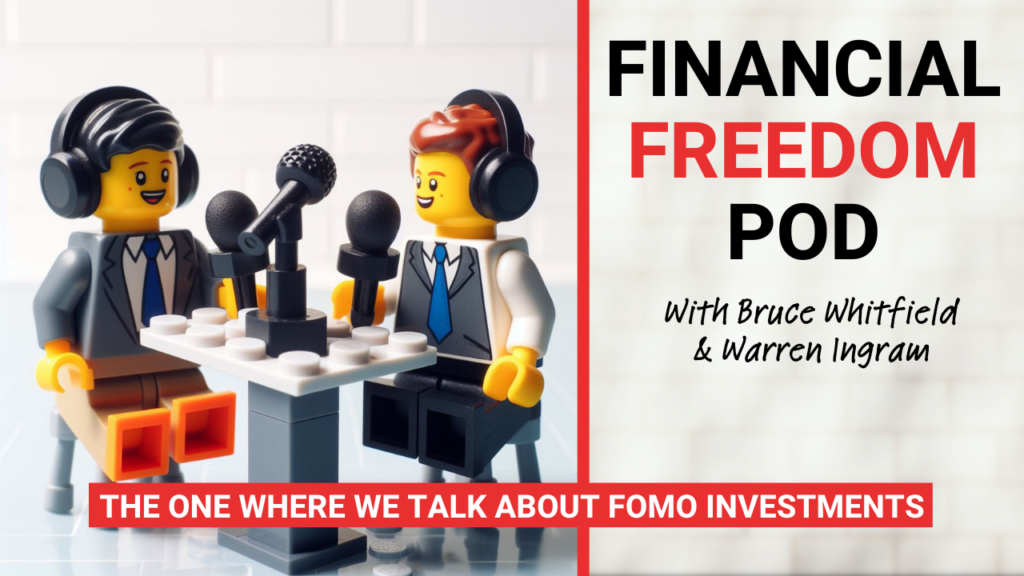
FOMO – the Fear of Missing Out is one of the most destructive forces of our age. In a social media charged world we are constantly looking at what we perceive to be others’ success and it’s easy to be drawn into their curated world with a firm belief that others have found a magical superpower that has eluded us.
It’s crucial to be aware of the pitfalls that can accompany the thrill of investing, particularly when influenced by FOMO.
Let’s delve into what FOMO investing is, its dangers, and how you can avoid falling into its trap.
So, what is FOMO Investing?
FOMO investing occurs when you make investment decisions based on the fear of missing out on potential gains. This fear is often fuelled by the fear of being left behind as others seem to profit from certain investment opportunities.
Whether it’s the latest hot stock, cryptocurrency, or trendy sector, FOMO can lead you to act impulsively, without conducting thorough research or considering your own financial goals and risk tolerance.
FOMO investing is driven by emotions rather than logic or a solid investment strategy. Making decisions based on fear or excitement can lead to poor choices and ultimately, losses.
It is driven by short-term thinking, assuming you have given your decision any thought at all, beyond the fact that it’s working for “them” so it must work for me. Investors influenced by FOMO tend to focus on short-term gains rather than long-term growth. This can result in a lack of diversification and exposure to unnecessary risk.
FOMO often stems from a desire to follow the crowd and not be left behind. However, investing based on the actions of others can lead to overcrowded trades and inflated asset prices, increasing the likelihood of a market correction.
There is also the risk of overtrading. If you have not done so, watch The Wolf of Wall Street, and if you have, watch it again. Jordan Belfort, whom I interviewed soon after he got out of jail, created an extraordinary machine where his traders were incentivised to go for commissions, effectively driving their customers, who must have, for a while at least, trusted them as experts.
“People don’t buy a stock; it gets sold to them,” says Leonardo DiCaprio playing Belfort in the movie.
FOMO investors find themselves trading frequently; buying and sell assets in an attempt to capture quick profits or avoid missing out on the next big opportunity. However, frequent trading can lead to high transaction costs and lower overall returns and once the tax authorities classify you as a trader they tax whatever you make, if you make anything at all, as a trader, rather than an investor and that gouges your gains over time. Odds are, the only people really making money are the brokerages and the people working on commission for them. If your broker is pushing you to make trades, ask them how they make their money and finish with: “Don’t call me, I’ll call you. Maybe.”
When caught up in FOMO, investors will ignore basic factors such as valuation, earnings potential, and market fundamentals. This can result in investing in overvalued investments whose price is being driven up by likeminded suckers all out to make a quick buck. It’s very hard to take a profit once an investment has gone up quickly in value. You will tell yourself that despite making a quick turn on an investment, you would hate to lose out should it double again. All too often by the time you wake up to the fact that you have been caught up in the hype cycle, your investment is worth less than you paid. Quick wins will make you feel like a genius and that is a very dangerous fiction.
Before making any investment, thoroughly research the asset, company, or sector you’re considering. Analyze financial statements, industry trends, and potential risks to make informed decisions.
This may sound boring.
Tough.
Define your investment objectives, understand your risk tolerance, and time horizon. Having a clear plan in place can help you resist the urge to make impulsive decisions based on FOMO.
Develop an investment strategy that aligns with your goals and risk tolerance. Whether it’s value investing, growth investing, or a combination of strategies, stick to your plan even when market sentiment is swayed by FOMO.
Make FOMO someone else’s problem. Not yours.
And diversify. Spread your investments across different asset classes, sectors, and geographic regions to reduce the impact of individual market movements. Diversification mitigates risk and protect your portfolio from the effects of FOMO-driven market volatility.
Avoid succumbing to the pressure of FOMO by staying disciplined and sticking to your investment plan. Tune out market noise and focus on the long-term growth potential of your investments.
This doesn’t give you the rush of chasing the hottest new trend.
In fact, avoiding the FOMO hype is quite boring in comparison.
You know what is more boring than approaching investments with caution and discipline?
Staring blankly at a white wall in a government run care facility at the age of 80 talking about what a great investor you used to be. That’s boring.






